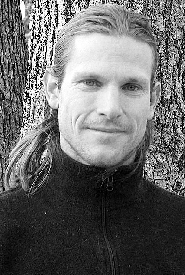Choreographer Spends Week At WIU As Artist in Residence
March 14, 2012

Professor of the Practice in Performing Arts David Marchant, of Washington University in St. Louis (MO) visited the WIU campus Feb. 18 – 23.
[Download Print-Quality Image]
MACOMB, IL – With creativity, fluidity of movement and a renewed sense of balance, Western Illinois University dance and theatre students recently welcomed a visiting artist into their classrooms.
Professor of the Practice in Performing Arts David Marchant, of Washington University in St. Louis (MO) visited the WIU campus Feb. 18 – 23. In addition to teaching classes, Marchant restaged a piece he choreographed at his home school in 2006 titled, "Belladonna Divertimento."
A production of the piece by eight WIU dancers will be performed April 26-28 at 7:30 p.m. each night as part of the University Dance Theatre's Spring Gala in Hainline Theatre.
Marchant said his contemporary dance piece is based in a mix of modern and balletic styles, and also gives the performers some freedom of personal expression. The eight-minute dance depicts a fictitional group of seven forest-dwelling female creatures, ambiguously fashioned between women, birds and insects, and one hapless man who encounters them when he becomes lost in their realm.
While serving as an artist in residence at WIU, Marchant taught a variety of classes, including modern dance for beginning dancers to advanced performers and dance composition.
"I'm trying to re-investigate basic technical skills, such as balance efficiency of movement." he said. "I find that trained dancers often have many assumptions about how to control their movement, some of which turn out to be ineffective, or even counter productive. I am always trying to discover how to make dancing easier, more natural."
Faculty Research
In addition to being a performing arts professor, Marchant has conducted research with fellow Washington University faculty on the impact of movement on the symptoms of Parkinson's disease.
Marchant said he was intrigued by research being conducted by Washington University Physical Therapy Professor Gammon Earhart and graduate student Madeline Hackney. Earhart and Hackney found tango dance to improve symptoms of Parkinson's disease.
Marchant proposed to Earhart to try the same kind of study, but with a modern dance form called "contact improvisation." This free-form improvisational dance involves partnering one Parkinson's patient and one student-volunteer creating and maintaining a point of physical contact.
"It could be something as simple as wrists touching and then they simply follow the common point of contact, giving and taking support from the pressure of their partner," Marchant said. "The activity requires constant adaptation to surprising weight shifts--something that people with Parkinson's disease typically fear. I was interested to see if they could do the dance form, and if learning to compensate for sudden changes would improve their balance."
Marchant, with co-authors, Jennifer Sylvester and Gammon Earhart, conducted a study with 14 participants, over two weeks, with pre and post-testing using several standardized measurements.
"We found significant improvements in balance and functional mobility. We published the result in the October 2010 issue of Complementary Therapies in Medicine, and I published a brief report for Contact Quarterly Newsletter in spring of 2011," he said.
Marchant said the study represents and "exciting potential" and he hopes to eventually do more in-depth study and also apply similar methods to a general group of aging adults to see if they would be effective for a general population.
"Falling in older adults is among the most injurious hazards facing an older adult," Marchant said. "I think it is possible that we could teach people better strategies to help reduce injuries from falling."
For more information on Marchant's work visit http://artsci.wustl.edu/~marchant/bio.htm.
Posted By: University Communications (U-Communications@wiu.edu)
Office of University Communications & Marketing

Connect with us: